
Despite its principal character being a rabbit, Warner Brothers was a little behind others in “hopping” wholeheartedly into TV production. It instead preferred to sandwich old animation into compilations with new wraparounds, such as in the successful “Bugs Bunny Show” package. It tried out a few pilots (not of the air variety), but none of them aired as series. After the conclusion of the first-run episodes of The Bugs Bunny Show, the program would go into endless rerun, largely ignoring the wraparounds and intended sequence of presentation of old material, and becoming a random packaging of the post-1947 cartoons. In the 1970’s, however, most likely inspired by the success of former studio veteran Chuck Jones in television specials such as How the Grinch Stole Christmas, Warner would contribute a sporadic series of holiday and non-holiday TV specials featuring the Looney Tunes gang, most of them provided by another of the studio’s “three old men”, Friz Freleng, through DePatie Freleng productions. Oddly, the studio never chose to produce specials through an in-house unit such as with the Cool Cat and Merlin the Magic Mouse shorts, nor appears to have made much use of the services of Robert McKimson, who had continued to work on said same late theatrical shorts up to the official cessation of theatrical releases. Eventually, however, the tides would change, in the wake of the syndicated mega-success of Disney’s Ducktales, and the studio, with the initial assistance of Steven Spielberg, would engage in a mass campaign of recruitment of fresh blood and farm-out of additional episodes to foreign producers, to amass the syndicated runs of Tiny Toon Adventures and other series which would follow as noted below.
 The Fright Before Christmas was the third title of Bugs Bunny’s Looney Christmas Tales (11/27/79), a collaborative effort produced for Warner by DePatie-Freleng and Chuck Jones (who contributed an original Road Runner installment). On Christmas eve, a plane flies over the North Pole, carrying a dangerous cargo of one crated Tasmanian Devil, who is supposed to be tranquilized, with his crate firmly tied down to the cargo bay floor. All of a sudden, a brown whirlwind of fur envelops the image of the crate from within, and the encasement is devoured to reveal Taz, in his usual ravenous mood. Before the pilots can decide what emergency measures to take, Taz removes their cause for further alarm, by whirlwind-drilling a hole in the plane’s floor, and dropping out – his arm returning through the hole only long enough to grab a parachute. Taz drops in on the North Pole haunts of Santa Claus, falling into the clothesline where Mrs. Claus has hung out Santa’s suit for a fresh cleaning before the evening’s big journey. Taz not only winds up in the suit himself, but lands in the driver’s seat of Santa’s sleigh, where the surprised reindeer team takes off with their new driver, toward their intended destination of the roofs of the children of the world. Of course, Bugs Bunny’s home is the first stop, with Bugs reading “The Night Before Christmas” to a nephew we’ve never seen before or since. (Why didn’t they use Clyde?) Hearing a landing on the roof, Bugs ushers the tyke upstairs, reminding him that Santa has a thing about kids not staying up past their bedtime. While Bugs wonders if the clatter could really be Santa, a curious Taz steps out of the sleigh onto the rim of Bugs’s frost-covered chimney, and falls in. Taking about three bounces on the way down, Taz emerges from the fireplace a sooty, bedraggled mess. “It really is Santa…or an unreasonable facsimile”, quips Bugs, borrowing a line from “The Unruly Hare”. Bugs suggests some goodies for Taz-Claus, including deviled eggs, deviled ham, or devil’s food cake, but can only come up with milk and cookies. Taz isn’t fickle, and not only devours the plate and its contents, but the whole dinner table.
The Fright Before Christmas was the third title of Bugs Bunny’s Looney Christmas Tales (11/27/79), a collaborative effort produced for Warner by DePatie-Freleng and Chuck Jones (who contributed an original Road Runner installment). On Christmas eve, a plane flies over the North Pole, carrying a dangerous cargo of one crated Tasmanian Devil, who is supposed to be tranquilized, with his crate firmly tied down to the cargo bay floor. All of a sudden, a brown whirlwind of fur envelops the image of the crate from within, and the encasement is devoured to reveal Taz, in his usual ravenous mood. Before the pilots can decide what emergency measures to take, Taz removes their cause for further alarm, by whirlwind-drilling a hole in the plane’s floor, and dropping out – his arm returning through the hole only long enough to grab a parachute. Taz drops in on the North Pole haunts of Santa Claus, falling into the clothesline where Mrs. Claus has hung out Santa’s suit for a fresh cleaning before the evening’s big journey. Taz not only winds up in the suit himself, but lands in the driver’s seat of Santa’s sleigh, where the surprised reindeer team takes off with their new driver, toward their intended destination of the roofs of the children of the world. Of course, Bugs Bunny’s home is the first stop, with Bugs reading “The Night Before Christmas” to a nephew we’ve never seen before or since. (Why didn’t they use Clyde?) Hearing a landing on the roof, Bugs ushers the tyke upstairs, reminding him that Santa has a thing about kids not staying up past their bedtime. While Bugs wonders if the clatter could really be Santa, a curious Taz steps out of the sleigh onto the rim of Bugs’s frost-covered chimney, and falls in. Taking about three bounces on the way down, Taz emerges from the fireplace a sooty, bedraggled mess. “It really is Santa…or an unreasonable facsimile”, quips Bugs, borrowing a line from “The Unruly Hare”. Bugs suggests some goodies for Taz-Claus, including deviled eggs, deviled ham, or devil’s food cake, but can only come up with milk and cookies. Taz isn’t fickle, and not only devours the plate and its contents, but the whole dinner table.
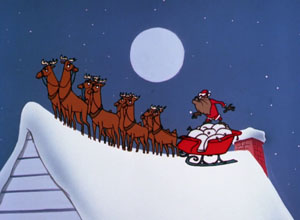 Bugs asks Taz to pause and “have a chair” (which Taz does by chewing it apart as another course of his meal), while he reads his nephew’s “brief” Christmas list – written on a mile-long scroll of paper. Many of the proposed gifts are comical and topical, including “a controlling interest in IBM, Frank Sinatra’s old address book”, and “twin Ferraris with custom plates”, wrapping up with, “a pony, a kitten, a little brother, and a partridge in a pear tree.” Taz meanwhile continues his meal, by devouring a string of bulbs off the Christmas tree. Bugs cautions him (without heed from Taz) that he shouldn’t eat the green ones, as they are not quite ripe – just as one makes Taz turn green and burp. Bugs calls “Santy” over to the fireplace (now lit) to thaw out, then produces a can of popcorn for a treat, asking Taz to hold it while he finds the popper. Having no idea what the stuff is, Taz swallows the whole can. With the sound effects of various pistol and rifle fire, the popcorn begins to explode inside of him, with the expected visual contortions to his body, and a final explosion of streams of the popped kernels out of his ears. “Couldn’t wait, huh?” says returning Bugs, in typical understatement. Taz pulls himself together and finally turns his attention to the gifts under the tree, about to devour one. Bugs taps him on the shoulder, and appears behind a fake prop sales counter (similar to Nasty Canasta’s “folding” bank in “Barbary Coast Bunny”), with a sign atop it reading “Gift Exchange”. He asks if Taz wishes a trade. Taz greedily holds onto the package he’s got, until Bugs offers him a much bigger one. Taz makes the trade, and is about to unwrap it, when Bugs says “Don’t open it in here. It’ll spoil the surprise.” Taz takes his prize outside and unwraps it, displaying his ignorance at being unable to comprehend the labeling, reading “Self-inflating rubber life raft”. Taz swallows the box whole, then a pop is heard. He bloats to the size of an inflated balloon, then floats skyward, headed for the moon. The writers make the mistake of killing Bugs’ delivery of a punch line by having him repeat what was written on the box for the benefit of non-reading kiddies in the audience (a condescending habit that was also over-indulged in by voice-overs placed upon Walter Lantz cartoons in early telecasts of The Woody Woodpecker Show), but the line should have been read. “I’m glad he liked the life raft. Tasmanian devils are so hard to buy for.” In an also over-explained coda, Bugs makes up for the lack of presents delivered to his nephew, by offering to act as driver to return Santa’s sleigh, which the real Santa should be so grateful to have back, that his nephew will have his pick of any toy on the lot. (But what about Santa’s suit, which Taz is still wearing? Is Santa supposed to make deliveries in his BVD’s?) Bugs ends it with the line to the audience, “Merry Christmas to all, and to all a good fight – er, uh, night!” It was one of those late Warner efforts which, while reasonably entertaining, probably played better on storyboard than in the final execution, due to a general feeling that some of the “edge” had been lost from the director’s, and even Blanc’s, early zing, and one suspects a totally different, livelier vibe would have been achieved if the same cast and crew had produced the same film circa 1956.
Bugs asks Taz to pause and “have a chair” (which Taz does by chewing it apart as another course of his meal), while he reads his nephew’s “brief” Christmas list – written on a mile-long scroll of paper. Many of the proposed gifts are comical and topical, including “a controlling interest in IBM, Frank Sinatra’s old address book”, and “twin Ferraris with custom plates”, wrapping up with, “a pony, a kitten, a little brother, and a partridge in a pear tree.” Taz meanwhile continues his meal, by devouring a string of bulbs off the Christmas tree. Bugs cautions him (without heed from Taz) that he shouldn’t eat the green ones, as they are not quite ripe – just as one makes Taz turn green and burp. Bugs calls “Santy” over to the fireplace (now lit) to thaw out, then produces a can of popcorn for a treat, asking Taz to hold it while he finds the popper. Having no idea what the stuff is, Taz swallows the whole can. With the sound effects of various pistol and rifle fire, the popcorn begins to explode inside of him, with the expected visual contortions to his body, and a final explosion of streams of the popped kernels out of his ears. “Couldn’t wait, huh?” says returning Bugs, in typical understatement. Taz pulls himself together and finally turns his attention to the gifts under the tree, about to devour one. Bugs taps him on the shoulder, and appears behind a fake prop sales counter (similar to Nasty Canasta’s “folding” bank in “Barbary Coast Bunny”), with a sign atop it reading “Gift Exchange”. He asks if Taz wishes a trade. Taz greedily holds onto the package he’s got, until Bugs offers him a much bigger one. Taz makes the trade, and is about to unwrap it, when Bugs says “Don’t open it in here. It’ll spoil the surprise.” Taz takes his prize outside and unwraps it, displaying his ignorance at being unable to comprehend the labeling, reading “Self-inflating rubber life raft”. Taz swallows the box whole, then a pop is heard. He bloats to the size of an inflated balloon, then floats skyward, headed for the moon. The writers make the mistake of killing Bugs’ delivery of a punch line by having him repeat what was written on the box for the benefit of non-reading kiddies in the audience (a condescending habit that was also over-indulged in by voice-overs placed upon Walter Lantz cartoons in early telecasts of The Woody Woodpecker Show), but the line should have been read. “I’m glad he liked the life raft. Tasmanian devils are so hard to buy for.” In an also over-explained coda, Bugs makes up for the lack of presents delivered to his nephew, by offering to act as driver to return Santa’s sleigh, which the real Santa should be so grateful to have back, that his nephew will have his pick of any toy on the lot. (But what about Santa’s suit, which Taz is still wearing? Is Santa supposed to make deliveries in his BVD’s?) Bugs ends it with the line to the audience, “Merry Christmas to all, and to all a good fight – er, uh, night!” It was one of those late Warner efforts which, while reasonably entertaining, probably played better on storyboard than in the final execution, due to a general feeling that some of the “edge” had been lost from the director’s, and even Blanc’s, early zing, and one suspects a totally different, livelier vibe would have been achieved if the same cast and crew had produced the same film circa 1956.
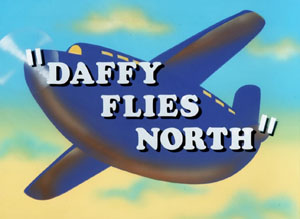 Ratings were decent enough for said Christmas special, that within a few short months, the studio would try it again to cover another holiday, this time centering on Daffy Duck, in an original half-hour that would prove to be far less perennial for prime-time rerun, Daffy Duck’s Easter Egg-Citement (4/1/80). The special was entirely produced by DePatie-Freleng without the assistance of Jones, and seemed to have considerably less energy and originality than its predecessor. The third instalment, Daffy Flies North, is largely a retread of old ground from the Pink Panther short, Pinto Pink, substituting Daffy in place of the Technicolor feline, looking for a quick mode of transportation when his wings give out on the return flight back North after a winter’s vacation. As with the Panther, he attempts to mount an old farm horse, who simply refuses to serve as his steed, and pulls various stunts and dirty tricks to avoid the saddle, repeatedly resulting in him giving the duck the horse laugh. Daffy’s final effort is a heroic swing on a rope from the upper landing of the barn, Daffy commenting that he always has a soft spot for swashbuckling. Unfortunately, his swing overshoots, and he lands on the back of an angry bull. The bull pursues Daffy to the local airport, where Daffy races up the ramp of the nearest plane, and slams the door in the bull’s face – not observing that he has just boarded a flight of South American Airways. The final shot finds him back to flapping, over the hills of Rio De Janeiro, where he grumbles about ending up in the deep South. “By the time I get North, the flock will be flying South again. What a life!”
Ratings were decent enough for said Christmas special, that within a few short months, the studio would try it again to cover another holiday, this time centering on Daffy Duck, in an original half-hour that would prove to be far less perennial for prime-time rerun, Daffy Duck’s Easter Egg-Citement (4/1/80). The special was entirely produced by DePatie-Freleng without the assistance of Jones, and seemed to have considerably less energy and originality than its predecessor. The third instalment, Daffy Flies North, is largely a retread of old ground from the Pink Panther short, Pinto Pink, substituting Daffy in place of the Technicolor feline, looking for a quick mode of transportation when his wings give out on the return flight back North after a winter’s vacation. As with the Panther, he attempts to mount an old farm horse, who simply refuses to serve as his steed, and pulls various stunts and dirty tricks to avoid the saddle, repeatedly resulting in him giving the duck the horse laugh. Daffy’s final effort is a heroic swing on a rope from the upper landing of the barn, Daffy commenting that he always has a soft spot for swashbuckling. Unfortunately, his swing overshoots, and he lands on the back of an angry bull. The bull pursues Daffy to the local airport, where Daffy races up the ramp of the nearest plane, and slams the door in the bull’s face – not observing that he has just boarded a flight of South American Airways. The final shot finds him back to flapping, over the hills of Rio De Janeiro, where he grumbles about ending up in the deep South. “By the time I get North, the flock will be flying South again. What a life!”
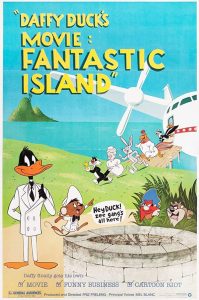 Daffy Duck’s Movie: Fantastic Island (8/5/83), again produced by DePatie-Freleng, is merely a “cheater” compilation of old Looney Tunes to return same to the big screen, using as its adhesive glue wraparound animation of Daffy Duck and Speedy Gonzales stranded on a desert island, but finding in the debris blasted from the explosion of Yosemite Sam’s nearby pirate ship a map which leads to a magic wishing well that will grant any wish for a penny. In direct lampoon of the then-current television hit, “Fantasy Island”, an anthology starring Ricardo Montalban as the omniscient proprietor of a magical island where dreams come true for a price, Daffy wishes the island into a similar resort, where he charges any Looney Tunes character $500 in exchange for one penny to drop into the well, each character achieving his dream through old stock footage. The only reason for mention of this poor excuse for a feature is Speedy’s portrayal of Montalban’s sidekick, midget actor Herve Villechaize, who every week gets to yell the signal that a new batch of visitors is arriving, “The plane! The plane!” Speedy in fact yells this very line over the opening credits of the film, as he is almost mowed down by the seaplane coming in for a landing.
Daffy Duck’s Movie: Fantastic Island (8/5/83), again produced by DePatie-Freleng, is merely a “cheater” compilation of old Looney Tunes to return same to the big screen, using as its adhesive glue wraparound animation of Daffy Duck and Speedy Gonzales stranded on a desert island, but finding in the debris blasted from the explosion of Yosemite Sam’s nearby pirate ship a map which leads to a magic wishing well that will grant any wish for a penny. In direct lampoon of the then-current television hit, “Fantasy Island”, an anthology starring Ricardo Montalban as the omniscient proprietor of a magical island where dreams come true for a price, Daffy wishes the island into a similar resort, where he charges any Looney Tunes character $500 in exchange for one penny to drop into the well, each character achieving his dream through old stock footage. The only reason for mention of this poor excuse for a feature is Speedy’s portrayal of Montalban’s sidekick, midget actor Herve Villechaize, who every week gets to yell the signal that a new batch of visitors is arriving, “The plane! The plane!” Speedy in fact yells this very line over the opening credits of the film, as he is almost mowed down by the seaplane coming in for a landing.
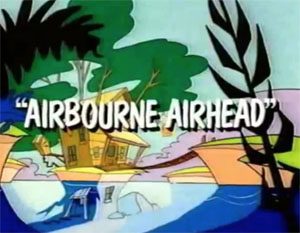 Airbourne Airhead (9/21/91), from “Taz-Mania”, introduces us to the Platypus Brothers, two blue collar construction workers/inventors in blue overalls, who talk and act like twins of Daffy Duck. They are perpetually over-helpful, and anxious to share and show off their creative genius to help their friend Taz. Unfortunately, their “genius” tends to be as ill-fated as Wile E. Coyote’s, but this problem rarely phases them, as it is Taz rather than themselves who usually takes the lumps. In this installment, Taz pops over around breakfast time, devouring not only the brothers’ supply of raw eggs, but their TV upon which they were watching a cooking show. But these little trifles won’t spoil a beautiful friendship. One of the brothers recalls where they can obtain more eggs, Taz-sized – in a nest high atop Pointy Peak, a huge, nearly vertical sloped mountain precariously balanced like a needle on a pedestal of stone. Taz races straight for the mountain, straight up – and straight down – over, and over, and over again. As the brothers realize Taz’s stubborn persistence and feeble brain are unlikely to progress him out of this endless loop of behavior, they offer their services to get Taz up the mountain. Their first efforts are more ground-based, straight out the Wile E. Coyote school of thinking, including strapping two RC controlled toy vehicles to Taz’s feet like roller shates, and attempting to aim him up the mountain by radio control (difficult, when each vehicle is guided by a separate controller), and suction cups on Taz’s feet (not helpful, when you walk up the side of a dislodegeable boulder). Then, the brothers get air-minded. A cap is strapped to Tax’s head, with a ring of fourth of July skyrockets bound around the brim, The rockets are ignited, but Taz at first remains grounded, nearly being hung by the semi-elastic strap under his chin. The strap finally springs back, lifting Taz only in time for the rockets to explode, unseen to the camera except for the red glare which flashes on the ground below, Then, the brothers construct a biplane, similar to the Wile E. Coyote pre-fab model from “Just Plane Beep”.
Airbourne Airhead (9/21/91), from “Taz-Mania”, introduces us to the Platypus Brothers, two blue collar construction workers/inventors in blue overalls, who talk and act like twins of Daffy Duck. They are perpetually over-helpful, and anxious to share and show off their creative genius to help their friend Taz. Unfortunately, their “genius” tends to be as ill-fated as Wile E. Coyote’s, but this problem rarely phases them, as it is Taz rather than themselves who usually takes the lumps. In this installment, Taz pops over around breakfast time, devouring not only the brothers’ supply of raw eggs, but their TV upon which they were watching a cooking show. But these little trifles won’t spoil a beautiful friendship. One of the brothers recalls where they can obtain more eggs, Taz-sized – in a nest high atop Pointy Peak, a huge, nearly vertical sloped mountain precariously balanced like a needle on a pedestal of stone. Taz races straight for the mountain, straight up – and straight down – over, and over, and over again. As the brothers realize Taz’s stubborn persistence and feeble brain are unlikely to progress him out of this endless loop of behavior, they offer their services to get Taz up the mountain. Their first efforts are more ground-based, straight out the Wile E. Coyote school of thinking, including strapping two RC controlled toy vehicles to Taz’s feet like roller shates, and attempting to aim him up the mountain by radio control (difficult, when each vehicle is guided by a separate controller), and suction cups on Taz’s feet (not helpful, when you walk up the side of a dislodegeable boulder). Then, the brothers get air-minded. A cap is strapped to Tax’s head, with a ring of fourth of July skyrockets bound around the brim, The rockets are ignited, but Taz at first remains grounded, nearly being hung by the semi-elastic strap under his chin. The strap finally springs back, lifting Taz only in time for the rockets to explode, unseen to the camera except for the red glare which flashes on the ground below, Then, the brothers construct a biplane, similar to the Wile E. Coyote pre-fab model from “Just Plane Beep”.
 To ensure Taz’s safety, they strap and padlock Taz into the pilot’s seat (never explaining how he is supposed to get out to retrieve the eggs). The plane takes off, while one of the brothers notices that one teeny tiny part was left behind unattached – the control stick. Taz helplessly bounces along from one mesa to the next, and shrieks and cringes as he finds himself aimed directly for the side of the peak. To complicate matters, the brothers’ construction work is apparently hampered by cheap nails and unturned bolts, as the plane begins to fall apart at the seams. The entire tail section falls away, then the cockpit sides, and finally, the wings. Taz furiously grabs the wings in each hand, seizes one wheel of the landing gear between his feet, and grabs the motor block in his mouth, in a desperate attempt to stay aloft. The mountainside looms ahead within inches – but to Taz’s amazement, he hits a strong updraft, lifting him into a position a few hundred feet above the peak. Then the engine dies. Taz falls, expecting the worst, but comes to a quick and reasonably comfortable landing – directly atop the eggs in the nest. Before he can begin thinking about preparing an omelette, cracks are heard, and the two eggs hatch into a pair of baby eagles. This development is far from upsetting to Taz, who envisions the birds barbecued. But just as he moves into pounce position, in flies Mama – three times bigger than Taz. Taz stops in his tracks and smiles a nervous toothy grin, but Mama simply eliminates Taz’s threat by flicking him off the cliff with her talons. In an extreme long shot, Taz falls, much like the “fly on the mesa” scene in Tex Avery’s “Drag-a-Long Droopy” – pausing in mid-air halfway down to catch a breath, so as to continue in a non-stop scream until he reaches the ground. The Platypus Brothers are finally out of ideas or reason to send Taz upwards any longer, and climb into their construction truck, noting that there’s nothing left for them to do but to inadvertently set in motion the episode’s surprise ending. They do so, by accidentally shifting the truck’s gear into reverse, colliding with the base of the peak. The impact upsets the precarious balance of the giant rock, and its descending shadow looms mightily over Taz, who flees at top speed in what seems a vain effort to avoid weighty disaster. A tremendous crash results as the entire mountain topples – but, strangely enough, right on the Platypus Brothers’ truck instead of Taz. All that protrudes from under the rock is the brothers’ bills, which comment regarding the ending, “Surprised me entirely.”
To ensure Taz’s safety, they strap and padlock Taz into the pilot’s seat (never explaining how he is supposed to get out to retrieve the eggs). The plane takes off, while one of the brothers notices that one teeny tiny part was left behind unattached – the control stick. Taz helplessly bounces along from one mesa to the next, and shrieks and cringes as he finds himself aimed directly for the side of the peak. To complicate matters, the brothers’ construction work is apparently hampered by cheap nails and unturned bolts, as the plane begins to fall apart at the seams. The entire tail section falls away, then the cockpit sides, and finally, the wings. Taz furiously grabs the wings in each hand, seizes one wheel of the landing gear between his feet, and grabs the motor block in his mouth, in a desperate attempt to stay aloft. The mountainside looms ahead within inches – but to Taz’s amazement, he hits a strong updraft, lifting him into a position a few hundred feet above the peak. Then the engine dies. Taz falls, expecting the worst, but comes to a quick and reasonably comfortable landing – directly atop the eggs in the nest. Before he can begin thinking about preparing an omelette, cracks are heard, and the two eggs hatch into a pair of baby eagles. This development is far from upsetting to Taz, who envisions the birds barbecued. But just as he moves into pounce position, in flies Mama – three times bigger than Taz. Taz stops in his tracks and smiles a nervous toothy grin, but Mama simply eliminates Taz’s threat by flicking him off the cliff with her talons. In an extreme long shot, Taz falls, much like the “fly on the mesa” scene in Tex Avery’s “Drag-a-Long Droopy” – pausing in mid-air halfway down to catch a breath, so as to continue in a non-stop scream until he reaches the ground. The Platypus Brothers are finally out of ideas or reason to send Taz upwards any longer, and climb into their construction truck, noting that there’s nothing left for them to do but to inadvertently set in motion the episode’s surprise ending. They do so, by accidentally shifting the truck’s gear into reverse, colliding with the base of the peak. The impact upsets the precarious balance of the giant rock, and its descending shadow looms mightily over Taz, who flees at top speed in what seems a vain effort to avoid weighty disaster. A tremendous crash results as the entire mountain topples – but, strangely enough, right on the Platypus Brothers’ truck instead of Taz. All that protrudes from under the rock is the brothers’ bills, which comment regarding the ending, “Surprised me entirely.”
 Batman, the Animated Series perhaps allowed for more frequent use of the Batplane than any prior animated adaptations, and certainly more than the budgets of the live-action TV series would have allowed. The Forgotten (10/8/92) features one such memorable instance. Bruce Wayne has gone undercover, posing as one of the city’s many homeless, to uncover the mystery of a series of disappearances of such individuals without a trace. He himself falls prey to a gang of kidnappers, who enslave their captives into forced labor in a mine. A blow from a blackjack takes Batman down, and also leads to a short -term memory loss, keeping him from devising any way to get in touch with Alfred or the authorities. At home, Alfred opens the morning curtains at Wayne Manor, to find Bruce’s bed empty. “Only vampires loathe daylight more than Batman. I wonder what’s keeping him?”, Alfred ponders. When Bruce fails to show up for the entire day, Alfred inspects the garage of cars below Wayne Manor. The Batmobile remains parked and unmoved, but Alfred notes an old Studebaker is missing. He engages the Bat-computer to seek out the homing device concealed under the vehicle, which locates the car parked in a junkyard next to the mission where the abduction took place. Alfred spots some tough types climbing into a truck, and plays a hunch, removing the tracking device from the Studebaker, and rolling under the truck to attach it to the bottom of the larger vehicle – then remains stock still to let the truck roll away over him. As the episode progresses at the mine and labor camp, Bruce regains his memory, and makes a daring escape from a sweatbox and up the steep walls of a box canyon, evading dogs and armed camp guards.
Batman, the Animated Series perhaps allowed for more frequent use of the Batplane than any prior animated adaptations, and certainly more than the budgets of the live-action TV series would have allowed. The Forgotten (10/8/92) features one such memorable instance. Bruce Wayne has gone undercover, posing as one of the city’s many homeless, to uncover the mystery of a series of disappearances of such individuals without a trace. He himself falls prey to a gang of kidnappers, who enslave their captives into forced labor in a mine. A blow from a blackjack takes Batman down, and also leads to a short -term memory loss, keeping him from devising any way to get in touch with Alfred or the authorities. At home, Alfred opens the morning curtains at Wayne Manor, to find Bruce’s bed empty. “Only vampires loathe daylight more than Batman. I wonder what’s keeping him?”, Alfred ponders. When Bruce fails to show up for the entire day, Alfred inspects the garage of cars below Wayne Manor. The Batmobile remains parked and unmoved, but Alfred notes an old Studebaker is missing. He engages the Bat-computer to seek out the homing device concealed under the vehicle, which locates the car parked in a junkyard next to the mission where the abduction took place. Alfred spots some tough types climbing into a truck, and plays a hunch, removing the tracking device from the Studebaker, and rolling under the truck to attach it to the bottom of the larger vehicle – then remains stock still to let the truck roll away over him. As the episode progresses at the mine and labor camp, Bruce regains his memory, and makes a daring escape from a sweatbox and up the steep walls of a box canyon, evading dogs and armed camp guards.
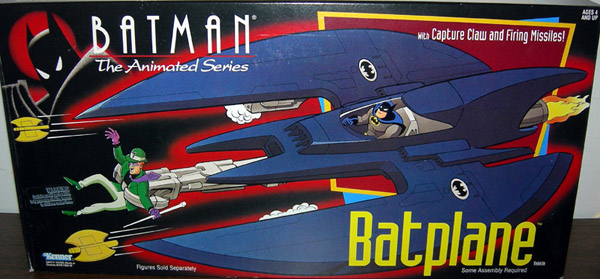
As Bruce continues to run, a familiar engine drone is heard approaching. Above flies the Batplane, with an unexpected pilot – a nervous, jittery Alfred in a crash helmet, who, without flight time behind the control stick of the craft, is relying entirely upon the craft’s computerized auto-pilot and tracking system to guide the plane to the location of the device left under the departing truck. Alfred moans and wails as the plane careens through narrow canyon passages, its radar systems detecting rocky walls on all sides. A blip on the screen detects the location of the tracking device below, and Alfred issues voice command to the computer to bring the craft down, as Master Bruce is there. A voice-response system, much like “Kitt” in the series, “Knight Rider”, replies “Impossible. Area too confined.” “Land, you bucket of bolts”, demands Alfred, pounding the control panel. “Your funeral”, responds the voice chip, in matter-of-factly tones. “Ohh, dear”, moans Alfred. The ship descends, rising and falling to miss rocky crags by inches, and buzzes past Bruce below, who, surmising who must be at the controls, remarks with notable admiration, “Son of a gun.” Finally finding a small patch of clear groud in the canyon floor, the plane locates just enough room to make a confined landing, the cockpit canopy automatically popping open when the plane is fully stopped. “Watch your step” says the computer voice in calm, disinterested manner. A nearly airsick Alfred stumbles and falls out of the cockpit and over the wing, landing on his face on the ground below. In a daze, he comically raises his head to announce, “I – I claim this land for Spain.” Up walks Bruce, who seats himself beside Alfred, and gives his old friend a playful sock on the cheek, in appreciation of an effort above and beyond the call of dedication.
We can’t post the complete episode – but here are some of the music cues:
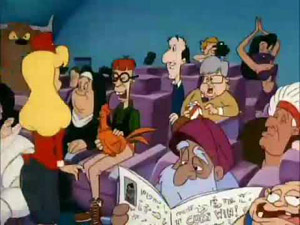 Two episodes from Steven Spielberg’s Animaniacs qualify for inclusion within these pages. Plane Pals (10/13/93) features Yakko, Wakko, and Dot, who, without explanation as to whether they stowed away or somehow obtained the fare, are all set for their first ride in a commercial jet. They take up three seats of the 4-seat wide center aisle, with an unlucky human, bumped from first class to coach, assigned to a seat between them. He is an irascible accountant named Ivan Blowsky, who tells the desk attendant who notified him of the seating error that he will buy the airline just to have the privilege to fire her. He plows through a line of boarding passengers, pushing them aside with such force, they leave silhouette impressions int the metal walls of the boarding ramp. He refers to his fellow man with expressions such as “Losers” and “Get a life!”, then tries to have everyone in coach thrown off so he can have some privacy. In short, he is just what the doctor ordered for the Warners’ brand of harassment.
Two episodes from Steven Spielberg’s Animaniacs qualify for inclusion within these pages. Plane Pals (10/13/93) features Yakko, Wakko, and Dot, who, without explanation as to whether they stowed away or somehow obtained the fare, are all set for their first ride in a commercial jet. They take up three seats of the 4-seat wide center aisle, with an unlucky human, bumped from first class to coach, assigned to a seat between them. He is an irascible accountant named Ivan Blowsky, who tells the desk attendant who notified him of the seating error that he will buy the airline just to have the privilege to fire her. He plows through a line of boarding passengers, pushing them aside with such force, they leave silhouette impressions int the metal walls of the boarding ramp. He refers to his fellow man with expressions such as “Losers” and “Get a life!”, then tries to have everyone in coach thrown off so he can have some privacy. In short, he is just what the doctor ordered for the Warners’ brand of harassment.
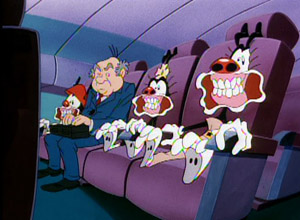 The Warners waste no time in giving him the treatment. They make their entrance with Wacko performing gymnastic bounces from the oxygen mask hose, Yakko wearing a pilot’s goggles and making sound effects and movements as if firing machine guns, and Dot extending her arms like wings and pretending to soar around her seat, adding the words “Tora. Tora.” Yakko introduces the trio to Blowsky, then announces they will be his travelling companions for the next 17 hours! A video appears onscreen to advise the passengers of the plane’s safety features. Wacko’s attention is directed to a paper bag in the rear compartment of the seat in front of him. “What’s this, mister?”, he asks Blowsky. “A vomit bag”, the sourpuss replies. “Aw pooh. I got gypped. There’s none in here”, grumbles Wacko. The Warners next test out their inflatable life jackets, pumping them to capacity with bicycle pumps until they explode, blasting Blowsky briefly out of his seat. “Sh – h – h – H – H- HHH!!!”, says Blowsky in their faces, adding “Do you know what that means?” “You have a slow leak?” asks Wacko. When oxygen masks are displayed, Yakko finds a “reverse” button on the accountant’s mask, sucking his face into the device. Finally, the film reminds everyone to fasten their seat belts. The Warners do – all upon Blowsky, who is wrapped up like a mummy. The instructional film concludes with the stewardess putting on a parachute and bailing out while the getting is good, assuring the audience that “You have well over a 40% chance of landing safely.”
The Warners waste no time in giving him the treatment. They make their entrance with Wacko performing gymnastic bounces from the oxygen mask hose, Yakko wearing a pilot’s goggles and making sound effects and movements as if firing machine guns, and Dot extending her arms like wings and pretending to soar around her seat, adding the words “Tora. Tora.” Yakko introduces the trio to Blowsky, then announces they will be his travelling companions for the next 17 hours! A video appears onscreen to advise the passengers of the plane’s safety features. Wacko’s attention is directed to a paper bag in the rear compartment of the seat in front of him. “What’s this, mister?”, he asks Blowsky. “A vomit bag”, the sourpuss replies. “Aw pooh. I got gypped. There’s none in here”, grumbles Wacko. The Warners next test out their inflatable life jackets, pumping them to capacity with bicycle pumps until they explode, blasting Blowsky briefly out of his seat. “Sh – h – h – H – H- HHH!!!”, says Blowsky in their faces, adding “Do you know what that means?” “You have a slow leak?” asks Wacko. When oxygen masks are displayed, Yakko finds a “reverse” button on the accountant’s mask, sucking his face into the device. Finally, the film reminds everyone to fasten their seat belts. The Warners do – all upon Blowsky, who is wrapped up like a mummy. The instructional film concludes with the stewardess putting on a parachute and bailing out while the getting is good, assuring the audience that “You have well over a 40% chance of landing safely.”
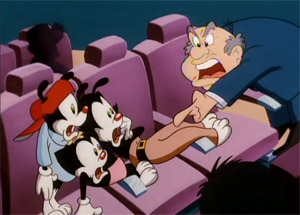 Blowsky is nearing his wit’s end as the plane takes off. Wacko asks what the tray in front of him is. “That’s for earing”, responds Blowsky. Wacko puts the tray between two slices of bread, and does just that. “Do you know who I am??”. demands Blowsky. No, but he doesn’t know who the Warners are, either, so they’re even. All Dot knows is that they like him – they have no taste, but they like him. With three big Bugs Bunny-style kisses, they dub Blowsky their “special friend”, and place around his neck a pink paper heart sign reading just that. Blowsky “blows”, and demands the stewardess change his seat. Finding the passenger list is full, he vows to make his own availability, storming into the first class section – but not before telling the Warners that he wishes he was preparing their taxes, so he could screw them up so bad the I.R.S. would bury them – and that he’d rather be eaten by cannibals than be their “special friend.” The Warners eyes well with tears, causing them to cry and wail – then break the mood entirely by making faces at him, leaving him storming off in a huff. In first class, Blowsky tells an unwitting passenger that he is “wanted outside”. Settling into the new seat, he finds a strangely familiar new companion by his side – Yakko, dressed in country garb, posing as a fertilizer salesman – with plenty of bags of samples along for Biowsky to take a whiff of. Blowsky runs to the opposite aisle, asking to change seats with what appears to be a parson – but is really Wacko. The seat is given to him – only causing further embarrassment, as Blowsky sits down upon a whoopee cushion. Dot next appears, disguised as a stewardess. “Coffee, tea, or monster?”, she asks. “Monster?” responds Blowsky. “Coming up”, answers Dot, opening a jack in the box that produces a live, snarling green beast. Blowsky’s hair nearly turns white, and Dot states he doesn’t look so good, then calls for a doctor.
Blowsky is nearing his wit’s end as the plane takes off. Wacko asks what the tray in front of him is. “That’s for earing”, responds Blowsky. Wacko puts the tray between two slices of bread, and does just that. “Do you know who I am??”. demands Blowsky. No, but he doesn’t know who the Warners are, either, so they’re even. All Dot knows is that they like him – they have no taste, but they like him. With three big Bugs Bunny-style kisses, they dub Blowsky their “special friend”, and place around his neck a pink paper heart sign reading just that. Blowsky “blows”, and demands the stewardess change his seat. Finding the passenger list is full, he vows to make his own availability, storming into the first class section – but not before telling the Warners that he wishes he was preparing their taxes, so he could screw them up so bad the I.R.S. would bury them – and that he’d rather be eaten by cannibals than be their “special friend.” The Warners eyes well with tears, causing them to cry and wail – then break the mood entirely by making faces at him, leaving him storming off in a huff. In first class, Blowsky tells an unwitting passenger that he is “wanted outside”. Settling into the new seat, he finds a strangely familiar new companion by his side – Yakko, dressed in country garb, posing as a fertilizer salesman – with plenty of bags of samples along for Biowsky to take a whiff of. Blowsky runs to the opposite aisle, asking to change seats with what appears to be a parson – but is really Wacko. The seat is given to him – only causing further embarrassment, as Blowsky sits down upon a whoopee cushion. Dot next appears, disguised as a stewardess. “Coffee, tea, or monster?”, she asks. “Monster?” responds Blowsky. “Coming up”, answers Dot, opening a jack in the box that produces a live, snarling green beast. Blowsky’s hair nearly turns white, and Dot states he doesn’t look so good, then calls for a doctor.
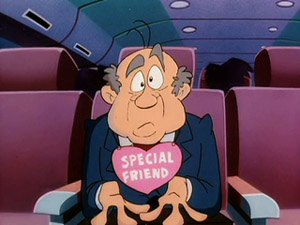 Wacko pops out of a luggage compartment above, drifting to the aisle floor with a parachute, then announces, “I’m a para-medic.” He gives Blowsky some air – from a helium tank, then pulls out the hose to let Blowsky deflate around the cabin ceiling. Yakko calls play-by-play in the garb of a Vin Scully-loke sportscaster, referring to Blowshy as a “long fly ball”, until he hits “the wall” – a brick one, quickly built in the aisle doorway by Yakko. While this and other madness ensue, inexplicably the Warners are seen by Blowsky outside on the wing, holding up a sign saying, “Be our special friend”. Blowsky decides to take things to the highest authority, and storms into the pilots’ cabin, demanding that someone do something to stop the Warners’ persecution of him. “What did you have in mind?”, answer the pilot, co-pilot, and navigator in unison – all now replaced by the Warners themselves. Blowsky runs back into the plane in panic, then spies an emergency box, marked “For fleeing villains only.” Breaking the glass, he obtains a parachute, and jumps out an emergency exit, landing on a small deserted island. Well, not quite deserted, as three “natives” concealed by tiki masks start chanting a war dance. Fearing the cannibals he talked about earlier, Blowsky dives into the sea, and paddles for nowhere in particular at top speed. The masks are thrown aside, to reveal the Warners. “Friends don’t let friends disappear over the horizon alone”, declares Yakko. Leaping into a three-passenger canoe, they paddle after Blowsky, yelling “Wait! “Come back! “We’re gonna make sloppy-Joes and rent Don Knotts videos!”
Wacko pops out of a luggage compartment above, drifting to the aisle floor with a parachute, then announces, “I’m a para-medic.” He gives Blowsky some air – from a helium tank, then pulls out the hose to let Blowsky deflate around the cabin ceiling. Yakko calls play-by-play in the garb of a Vin Scully-loke sportscaster, referring to Blowshy as a “long fly ball”, until he hits “the wall” – a brick one, quickly built in the aisle doorway by Yakko. While this and other madness ensue, inexplicably the Warners are seen by Blowsky outside on the wing, holding up a sign saying, “Be our special friend”. Blowsky decides to take things to the highest authority, and storms into the pilots’ cabin, demanding that someone do something to stop the Warners’ persecution of him. “What did you have in mind?”, answer the pilot, co-pilot, and navigator in unison – all now replaced by the Warners themselves. Blowsky runs back into the plane in panic, then spies an emergency box, marked “For fleeing villains only.” Breaking the glass, he obtains a parachute, and jumps out an emergency exit, landing on a small deserted island. Well, not quite deserted, as three “natives” concealed by tiki masks start chanting a war dance. Fearing the cannibals he talked about earlier, Blowsky dives into the sea, and paddles for nowhere in particular at top speed. The masks are thrown aside, to reveal the Warners. “Friends don’t let friends disappear over the horizon alone”, declares Yakko. Leaping into a three-passenger canoe, they paddle after Blowsky, yelling “Wait! “Come back! “We’re gonna make sloppy-Joes and rent Don Knotts videos!”
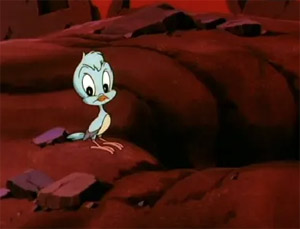 Wild Blue Yonder (11/22/93), is a surprise one-shot from the series, spotlighting a nest of eggs, left briefly unattended by a mother bluebird, taking a break to forage. One fledgling hatches ahead of schedule, and looks around for its mother. A black streak passes overhead – the now familiar silhouette of a stealth bomber The baby starts imitating its sound with ”zoom zoom”s, and calls after it. “Mama. Wait up.” A quick study on flying, the bird tries desperately to catch up, far into the night. He sights another flying object – a WWI German biplane! Confused, he starts to imitate the sounds of the ancient fighter’s machine guns. But when he attempts to fly in close, he discovers it is only a two-dimensional image on a drive-in movie screen, and crashes into it. By next morning, he makes visual contact with the stealth jet, which has landed at a desert air force base. The chick is fascinated by the array of huge “birds” along the runways, finally finding “Mama”, with whom he attempts to bond. Mama gets ready for takeoff again on another mission, and the bird interprets a flip of the plane’s ailerons as a beckon to follow. Baby mirrors the moves of the big plane’s landing gear in rising from the ground, and catches up with Mama just as the plane folds its wheels into its body, taking Baby inside with them. Now in the bomb bay, Junior sees row after row of round-nosed bombs. “Eggies”, shouts Junior. He greets each bomb, “Hello, little brother. Hello little sister.”
Wild Blue Yonder (11/22/93), is a surprise one-shot from the series, spotlighting a nest of eggs, left briefly unattended by a mother bluebird, taking a break to forage. One fledgling hatches ahead of schedule, and looks around for its mother. A black streak passes overhead – the now familiar silhouette of a stealth bomber The baby starts imitating its sound with ”zoom zoom”s, and calls after it. “Mama. Wait up.” A quick study on flying, the bird tries desperately to catch up, far into the night. He sights another flying object – a WWI German biplane! Confused, he starts to imitate the sounds of the ancient fighter’s machine guns. But when he attempts to fly in close, he discovers it is only a two-dimensional image on a drive-in movie screen, and crashes into it. By next morning, he makes visual contact with the stealth jet, which has landed at a desert air force base. The chick is fascinated by the array of huge “birds” along the runways, finally finding “Mama”, with whom he attempts to bond. Mama gets ready for takeoff again on another mission, and the bird interprets a flip of the plane’s ailerons as a beckon to follow. Baby mirrors the moves of the big plane’s landing gear in rising from the ground, and catches up with Mama just as the plane folds its wheels into its body, taking Baby inside with them. Now in the bomb bay, Junior sees row after row of round-nosed bombs. “Eggies”, shouts Junior. He greets each bomb, “Hello, little brother. Hello little sister.”
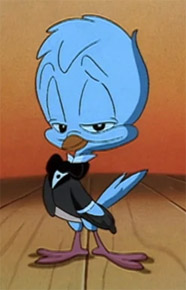 Sitting atop one of them, he fails to notice the hatch doors opening under him, until, too late, he reacts, “Uh oh.” Birdie and bomb, along with several other bombs from the plane’s payload, fall toward a target area below, littered with the shells of other bombing runs. “No, Mama. Eggies gonna break. Eggies gonna break”, says the little bird. Desperately he attempts to lift the nose of the bomb he is astride against the force of gravity, to no avail. Abandoning the “egg” just short of impact, the bird braces himself, as he is hit by the shock wave of the blasts from below. He swoops down to the charred crater left by the explosion, and turns to the audience with a profound understatement: “Eggies broke.” Looking upward, he discovers to his shock that “Mama” is making another pass, and we see reflected in his eyes another wave of bombs falling straight for him. Junior decides he’s had enough, and wings his way out of there, dodging a hail of new explosions. Days later, he returns to his old nest in the park. There, to his surprise, he finds the nest occupied by the endearing form of his real mother. “Mama?”, the chick asks questioningly. Mama spreads her wings wide and embraces him. A happy reunion ensues, and Mama leaves baby in charge while she tries to find him some worms. At this moment, the other two eggs finally hatch, calling for “Mama?” Mama?” The bomber again passes above on another flyby. The new chicks begin a unison “zoom zoom” just like their sibling, but Junior tries to set them straight. “No. Not Mama.” Exchanging a look between themselves, the two chicks ignore him and go back to zooming. Frustrated, Junior asides to the audience in disgruntled tone, “Kids!”. Fortunately, history doesn’t repeat itself, as real mother returns, whom Junior points to reassuringly as “Mama”, and the whole family happily embrace for the fade out. A classy cartoon, with excellent dimension and effects work, plus heart, of which Spielberg should have been proud.
Sitting atop one of them, he fails to notice the hatch doors opening under him, until, too late, he reacts, “Uh oh.” Birdie and bomb, along with several other bombs from the plane’s payload, fall toward a target area below, littered with the shells of other bombing runs. “No, Mama. Eggies gonna break. Eggies gonna break”, says the little bird. Desperately he attempts to lift the nose of the bomb he is astride against the force of gravity, to no avail. Abandoning the “egg” just short of impact, the bird braces himself, as he is hit by the shock wave of the blasts from below. He swoops down to the charred crater left by the explosion, and turns to the audience with a profound understatement: “Eggies broke.” Looking upward, he discovers to his shock that “Mama” is making another pass, and we see reflected in his eyes another wave of bombs falling straight for him. Junior decides he’s had enough, and wings his way out of there, dodging a hail of new explosions. Days later, he returns to his old nest in the park. There, to his surprise, he finds the nest occupied by the endearing form of his real mother. “Mama?”, the chick asks questioningly. Mama spreads her wings wide and embraces him. A happy reunion ensues, and Mama leaves baby in charge while she tries to find him some worms. At this moment, the other two eggs finally hatch, calling for “Mama?” Mama?” The bomber again passes above on another flyby. The new chicks begin a unison “zoom zoom” just like their sibling, but Junior tries to set them straight. “No. Not Mama.” Exchanging a look between themselves, the two chicks ignore him and go back to zooming. Frustrated, Junior asides to the audience in disgruntled tone, “Kids!”. Fortunately, history doesn’t repeat itself, as real mother returns, whom Junior points to reassuringly as “Mama”, and the whole family happily embrace for the fade out. A classy cartoon, with excellent dimension and effects work, plus heart, of which Spielberg should have been proud.
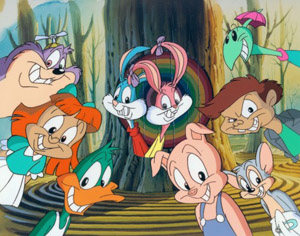 Tiny Toons Night Ghoulery (5/28/95), was a prime-time hour special featuring the gang from Tiny Toon Adventures, consisting of several short episodes with wraparound animation, paying homage to Rod Serling’s chilling anthology series “Night Gallery” and “The Twilight Zone”. Its broadcast seems to have been delayed from intended airing for the previous Halloween, for unknown reasons. The final segment, A Gremlin on a Wing, parodies a famous Twilight Zone installment, Nightmare at 20,000 Feet. It actually works on two levels, playing equally off the fact that the star of the original “Zone” episode was William Shatner, in a pre-Star Trek role. The writers can’t resist having Plucky Duck, who plays the Shatner part, read his lines in the manner of Captain Kirk of the Enterprise, and tossing in every Star Trek reference possible in the characters’ dialogue – even going so far as to include a stewardess who is a dead ringer for Nichelle Nichols as Uhura.
Tiny Toons Night Ghoulery (5/28/95), was a prime-time hour special featuring the gang from Tiny Toon Adventures, consisting of several short episodes with wraparound animation, paying homage to Rod Serling’s chilling anthology series “Night Gallery” and “The Twilight Zone”. Its broadcast seems to have been delayed from intended airing for the previous Halloween, for unknown reasons. The final segment, A Gremlin on a Wing, parodies a famous Twilight Zone installment, Nightmare at 20,000 Feet. It actually works on two levels, playing equally off the fact that the star of the original “Zone” episode was William Shatner, in a pre-Star Trek role. The writers can’t resist having Plucky Duck, who plays the Shatner part, read his lines in the manner of Captain Kirk of the Enterprise, and tossing in every Star Trek reference possible in the characters’ dialogue – even going so far as to include a stewardess who is a dead ringer for Nichelle Nichols as Uhura.
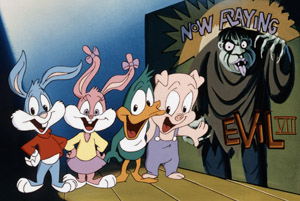 Opening narration is provided in the manner of an entry into the captain’s log on a typical Trek episode, though Plucky is not captain of a passenger jet – but just a passenger. His data entry makes it appear that he is busy attempting to calm Hamton Pig, his traveling companion, from his fears about flying. In reality, it is Plucky whose teeth are chattering in fear, and who is trying his best to hide himself between the cushions and armrests of his seat near the emergency exit. Hamton is calmly informing him of statistics that flying is 75% safer than driving, 45% safer than sitting on a pile of scorpions, and 5% safer than swallowing a tarantula. Hamton puts on a night cap, and decides to get some shuteye. Plucky attempts to take his suggestion, calm down and relax – until he spots a little green man, applying a jack-hammer to the number four engine outside the window. It is Bob Clampett’s gremlin, straight out of Bugs Bunny’s Falling Hare – complete with background musical stings of “Dark Eyes” to also remind us of the “Gremlins From the Kremlin” number from Russian Rhapsody. The Gremlin shifts weaponry, pulling out a chainsaw, and carves away a portion of the engine cowling, leaving bare wires exposed, severed, and shorting. Plucky tries to get a hold of himself, stating there can’t possibly be a gremlin outside. But the little creature appears at the window, quoting another recognizable line from a Clampett classic, “Draftee Daffy” – “Well, I wouldn’t say that!” (originally the catch-phrase of druggist Peavey from “The Great Gildersleeve” radio show).
Opening narration is provided in the manner of an entry into the captain’s log on a typical Trek episode, though Plucky is not captain of a passenger jet – but just a passenger. His data entry makes it appear that he is busy attempting to calm Hamton Pig, his traveling companion, from his fears about flying. In reality, it is Plucky whose teeth are chattering in fear, and who is trying his best to hide himself between the cushions and armrests of his seat near the emergency exit. Hamton is calmly informing him of statistics that flying is 75% safer than driving, 45% safer than sitting on a pile of scorpions, and 5% safer than swallowing a tarantula. Hamton puts on a night cap, and decides to get some shuteye. Plucky attempts to take his suggestion, calm down and relax – until he spots a little green man, applying a jack-hammer to the number four engine outside the window. It is Bob Clampett’s gremlin, straight out of Bugs Bunny’s Falling Hare – complete with background musical stings of “Dark Eyes” to also remind us of the “Gremlins From the Kremlin” number from Russian Rhapsody. The Gremlin shifts weaponry, pulling out a chainsaw, and carves away a portion of the engine cowling, leaving bare wires exposed, severed, and shorting. Plucky tries to get a hold of himself, stating there can’t possibly be a gremlin outside. But the little creature appears at the window, quoting another recognizable line from a Clampett classic, “Draftee Daffy” – “Well, I wouldn’t say that!” (originally the catch-phrase of druggist Peavey from “The Great Gildersleeve” radio show).
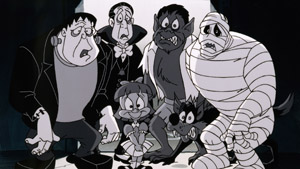 Of course, no matter how hard Plucky tries to get the attention of Hamton and the stewardess, the gremlin has always darted out of sight whenever they look out the window. The stewardess decides Plucky needs some calming down – and bashes him into a placid state with a blow from a serving tray. The gremlin meanwhile moves to the next engine, and begins carving at the wing surface with a fork and knife, cutting out a panel of metal, and eating it! Plucky tells Hamton a gremlin is eating the engine. Hamton mistakes the subject of conversation for a car of the same name of the period, and tells Plucky that Gremlins don’t eat much gas – just like Pintos. By now, the gremlin has tied to the wing about forty cases of dynamite, and a giant cartoon bomb, with his only obstacle to total destruction being that he can’t seem to get his cigarette lighter to work to ignite the fuse. “Must save ship”, says Plucky to himself. On the opposite wall of the plane’s cabin, he sees a high-pressure fire hose in a emergency box. Plucky clambers across the laps of the passengers in the row to retrieve the nozzle, then opens the emergency door, causing himself and most of the hose to be sucked outside for a tethered spacewalk. Though the rest of the passengers are left in a terrifying suction vacuum, the open hatchway is quickly plugged by the wide derriere of the Uhura stewardess. Outside, as Plucky dangles in air a few feet from the gremlin, the little man politely asks Plucky if he has a light, and equally polite Plucky reflexively hands him his own cigarette lighter – then reacts the same as Bugs in Falling Hare – “WHAT AM I DOING???” Plucky turns on the nozzle of the hose when the gremlin succeeds in lighting the fuse, but the force of the stream of water shoots Plucky in every direction, then into a spiral around the plane, which wraps Plucky up, tied securely in knots against the fuselage, though miraculously not cutting off the flow of water. “Goodbye, Mr. Duck”, says the gremlin, giving Plucky a big Bugs Bunny-style kiss, then calmly floats away into the sky. The only things Plucky can move are his neck and beak, so he clenches the hose nozzle in his bill, and tries desperately to aim the stream of water at the explosives on the far end of the wing. Closer, evert closer, comes the water to the fuse, as Plucky’s eyes assume the shape of bombs with fuses about to reach detonation point – and the scene fades to black. The final sequence shows the plane safely upon the ground, although at least some of the explosives have blasted away the engine pod to which they were tied. But Plucky’s efforts appear to have kept the catastrophe from becoming much worse. Plucky is wheeled out of the plane on an ambulance gurney, while Hamton states, “Everyone’s safe now, Plucky.” “Yes,” responds the dazed and battered duck, “but I’m the only one who knows why.” To one side stands the Uhura stewardess, looking on. She tugs at her own cheek, and removes it – revealing she has been wearing a whole-head Halloween mask, inside of which is the face of – the gremlin! “Well, I wouldn’t say that”, he repeats to the audience, for the iris out.
Of course, no matter how hard Plucky tries to get the attention of Hamton and the stewardess, the gremlin has always darted out of sight whenever they look out the window. The stewardess decides Plucky needs some calming down – and bashes him into a placid state with a blow from a serving tray. The gremlin meanwhile moves to the next engine, and begins carving at the wing surface with a fork and knife, cutting out a panel of metal, and eating it! Plucky tells Hamton a gremlin is eating the engine. Hamton mistakes the subject of conversation for a car of the same name of the period, and tells Plucky that Gremlins don’t eat much gas – just like Pintos. By now, the gremlin has tied to the wing about forty cases of dynamite, and a giant cartoon bomb, with his only obstacle to total destruction being that he can’t seem to get his cigarette lighter to work to ignite the fuse. “Must save ship”, says Plucky to himself. On the opposite wall of the plane’s cabin, he sees a high-pressure fire hose in a emergency box. Plucky clambers across the laps of the passengers in the row to retrieve the nozzle, then opens the emergency door, causing himself and most of the hose to be sucked outside for a tethered spacewalk. Though the rest of the passengers are left in a terrifying suction vacuum, the open hatchway is quickly plugged by the wide derriere of the Uhura stewardess. Outside, as Plucky dangles in air a few feet from the gremlin, the little man politely asks Plucky if he has a light, and equally polite Plucky reflexively hands him his own cigarette lighter – then reacts the same as Bugs in Falling Hare – “WHAT AM I DOING???” Plucky turns on the nozzle of the hose when the gremlin succeeds in lighting the fuse, but the force of the stream of water shoots Plucky in every direction, then into a spiral around the plane, which wraps Plucky up, tied securely in knots against the fuselage, though miraculously not cutting off the flow of water. “Goodbye, Mr. Duck”, says the gremlin, giving Plucky a big Bugs Bunny-style kiss, then calmly floats away into the sky. The only things Plucky can move are his neck and beak, so he clenches the hose nozzle in his bill, and tries desperately to aim the stream of water at the explosives on the far end of the wing. Closer, evert closer, comes the water to the fuse, as Plucky’s eyes assume the shape of bombs with fuses about to reach detonation point – and the scene fades to black. The final sequence shows the plane safely upon the ground, although at least some of the explosives have blasted away the engine pod to which they were tied. But Plucky’s efforts appear to have kept the catastrophe from becoming much worse. Plucky is wheeled out of the plane on an ambulance gurney, while Hamton states, “Everyone’s safe now, Plucky.” “Yes,” responds the dazed and battered duck, “but I’m the only one who knows why.” To one side stands the Uhura stewardess, looking on. She tugs at her own cheek, and removes it – revealing she has been wearing a whole-head Halloween mask, inside of which is the face of – the gremlin! “Well, I wouldn’t say that”, he repeats to the audience, for the iris out.
Here’s the intro…
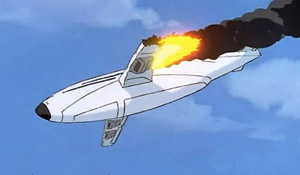 The Last Son of Krypton (9/6/96), a special triple-length series opener for Warner’s Superman animated series, contains in part 3 a memorable rescue of a jumbo jet. Lex Luthor is in the middle of a public demonstration of a billion-dollar battle suit, when it is stolen by a hovercraft of unknown terrorists. (As it later turns out, the theft is rigged, so Luthor can make a clandestine sale to a hostile nation under a trade embargo, then potentially land a defense deal for bigger suits to counter it.) Superman, not yet knowing the plot, makes one of his first public appearances in Metropolis, removing his Clark Kent garb to reveal the traditional suit for the first time to the general public. He battles the enemy craft and agents in rocket packs, but a heat-seeking missile misses him, and instead zeroes in on the engine of a passing jumbo jet, taking out one engine and part of its wing. The crippled plane begins to careen toward the heart of the city. Much in the tradition of “Japoteurs”, Superman faces the challenge of attempting to stop a massive object in mid-air. His first thought is to try to grip the plane from behind, and hold it back. He wraps his arms around the rudder and tail, clutching into the metal with all his might, until the aluminum crinkles in his grip from metal fatigue. Then, the tail snaps off just below his grip point, leaving Superman spiraling backwards with the huge part still in his arms, while the plummeting plane becomes even more helpless with no means of steering. “Nice one, Clark”, Superman verbally berates himself. He then flies ahead, positioning himself under the nose of the plane, which is now dipping low enough to be parallel with the tops of tall buildings.
The Last Son of Krypton (9/6/96), a special triple-length series opener for Warner’s Superman animated series, contains in part 3 a memorable rescue of a jumbo jet. Lex Luthor is in the middle of a public demonstration of a billion-dollar battle suit, when it is stolen by a hovercraft of unknown terrorists. (As it later turns out, the theft is rigged, so Luthor can make a clandestine sale to a hostile nation under a trade embargo, then potentially land a defense deal for bigger suits to counter it.) Superman, not yet knowing the plot, makes one of his first public appearances in Metropolis, removing his Clark Kent garb to reveal the traditional suit for the first time to the general public. He battles the enemy craft and agents in rocket packs, but a heat-seeking missile misses him, and instead zeroes in on the engine of a passing jumbo jet, taking out one engine and part of its wing. The crippled plane begins to careen toward the heart of the city. Much in the tradition of “Japoteurs”, Superman faces the challenge of attempting to stop a massive object in mid-air. His first thought is to try to grip the plane from behind, and hold it back. He wraps his arms around the rudder and tail, clutching into the metal with all his might, until the aluminum crinkles in his grip from metal fatigue. Then, the tail snaps off just below his grip point, leaving Superman spiraling backwards with the huge part still in his arms, while the plummeting plane becomes even more helpless with no means of steering. “Nice one, Clark”, Superman verbally berates himself. He then flies ahead, positioning himself under the nose of the plane, which is now dipping low enough to be parallel with the tops of tall buildings.
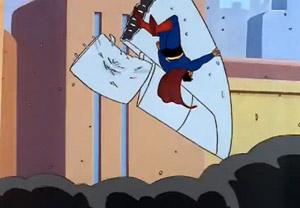 With nothing to brace against, Superman finds it difficult to have an effect upon slowing the plane, but with great effort shifts his weight to veer the nose slightly to the left, narrowly avoiding a collision with a row of buildings and gradually aligning the plane with the direction of the street below. Pedestrians and vehicles run for cover as the plane continues to descend. Superman now centers himself further below the plane’s nose, and pushes upward, straining every muscle to its limit. The plane approaches a large city park, where it makes contact with the top of a grove of trees. Superman takes a beating, his form smashing through row after row of tree limbs as the plane grazes the top of the grove like a lawn mower. At the end of the grove is a central lake, where a couple in a canoe narrowly miss the forceful splashdown of Superman and the plane into the water, skimming over the surface like a thrown stone. The plane still does not stop, and slides up the opposite bank, burying Superman in the mud and debris. The plane skids toward the steps of a Metropolis museum, where a mime unknowingly continues to attempt to entertain a crowd, while the nose of the plane looms menacingly above him. The crowd disperses, and the mime is the last to turn around, breaking his silence with an audible gasp, as the plane finally comes to a stop, only inches from him. Despite perhaps being a little soiled, Superman emerges from the towering heap of excavated dirt under the plane’s belly, as the plane’s passengers disembark via emergency slides (we hope not too bruised from the rough landing). Superman departs into the skies, receiving cheers from various townsfolk – and the curiosity of the world turns to who is this mysterious flying visitor. Photos taken by citizens of his departure are studied by Lois, who observes the “S” on his shirt, and Christens him with the catchy moniker, “Superman”.
With nothing to brace against, Superman finds it difficult to have an effect upon slowing the plane, but with great effort shifts his weight to veer the nose slightly to the left, narrowly avoiding a collision with a row of buildings and gradually aligning the plane with the direction of the street below. Pedestrians and vehicles run for cover as the plane continues to descend. Superman now centers himself further below the plane’s nose, and pushes upward, straining every muscle to its limit. The plane approaches a large city park, where it makes contact with the top of a grove of trees. Superman takes a beating, his form smashing through row after row of tree limbs as the plane grazes the top of the grove like a lawn mower. At the end of the grove is a central lake, where a couple in a canoe narrowly miss the forceful splashdown of Superman and the plane into the water, skimming over the surface like a thrown stone. The plane still does not stop, and slides up the opposite bank, burying Superman in the mud and debris. The plane skids toward the steps of a Metropolis museum, where a mime unknowingly continues to attempt to entertain a crowd, while the nose of the plane looms menacingly above him. The crowd disperses, and the mime is the last to turn around, breaking his silence with an audible gasp, as the plane finally comes to a stop, only inches from him. Despite perhaps being a little soiled, Superman emerges from the towering heap of excavated dirt under the plane’s belly, as the plane’s passengers disembark via emergency slides (we hope not too bruised from the rough landing). Superman departs into the skies, receiving cheers from various townsfolk – and the curiosity of the world turns to who is this mysterious flying visitor. Photos taken by citizens of his departure are studied by Lois, who observes the “S” on his shirt, and Christens him with the catchy moniker, “Superman”.
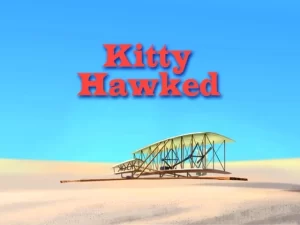 From Tom and Jerry Tales, we get Kitty Hawked (12/8/07). At the national Air and Space Museum, a guided tour is in progress – by an elderly brown mouse with white sideburns in a tour guide’s outfit, to a group of school-age white mice. The guide states he’s saved the best for last, although it was a first – the original Wright Flyer, which gave the world the first powered “moused flight”. “Don’t you mean manned flight?”, comments one of the schoolmice. “No, moused flight”, responds the guide, and begins to relate the story of the brave mouse responsible for the feat. In flashback, we are transported to the Wright Brothers’ bicycle shop, where the brothers are busy building their normal stock in trade, testing the rotation of a wheel with a bicycle chain. Jerry, preparing a morning meal from the brothers’ pantry right under their noses, uses the spokes of the rotating wheel as a salami slicer to prepare himself a sandwich. Orville calls upon his “useless cat” (Tom) to pursue the mouse on one of the brothers’ completed vehicles. Tom crashes, the handlebars of the bicycle entwining around his head like bulls’ horns. Jerry meanwhile spies a poster advertising a brand of bicycle parts called “Flying Wheels”, and tears off two images of paper wings upon the poster to use in flapping to make a getaway out the window, while Tom is trapped as the window frame crashes on his head. Wilbur observes that the mouse seems to have knowledge of principles of aerodynamics – and a talent for outsmarting Tom. Both may prove useful in forwarding the brothers’ experiments.
From Tom and Jerry Tales, we get Kitty Hawked (12/8/07). At the national Air and Space Museum, a guided tour is in progress – by an elderly brown mouse with white sideburns in a tour guide’s outfit, to a group of school-age white mice. The guide states he’s saved the best for last, although it was a first – the original Wright Flyer, which gave the world the first powered “moused flight”. “Don’t you mean manned flight?”, comments one of the schoolmice. “No, moused flight”, responds the guide, and begins to relate the story of the brave mouse responsible for the feat. In flashback, we are transported to the Wright Brothers’ bicycle shop, where the brothers are busy building their normal stock in trade, testing the rotation of a wheel with a bicycle chain. Jerry, preparing a morning meal from the brothers’ pantry right under their noses, uses the spokes of the rotating wheel as a salami slicer to prepare himself a sandwich. Orville calls upon his “useless cat” (Tom) to pursue the mouse on one of the brothers’ completed vehicles. Tom crashes, the handlebars of the bicycle entwining around his head like bulls’ horns. Jerry meanwhile spies a poster advertising a brand of bicycle parts called “Flying Wheels”, and tears off two images of paper wings upon the poster to use in flapping to make a getaway out the window, while Tom is trapped as the window frame crashes on his head. Wilbur observes that the mouse seems to have knowledge of principles of aerodynamics – and a talent for outsmarting Tom. Both may prove useful in forwarding the brothers’ experiments.
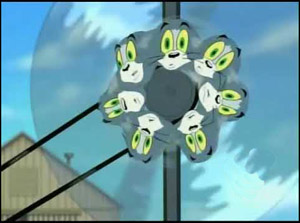 The brothers construct a mouse-sized box-kite, leaving it and a small coil of attached rope in a ready position on a rooftop for use by the mouse if he should happen by. Sure enough, Jerry comes along, with Tom right behind. Jerry spots the box-kite, and takes off like a glider off the roof. Tom grabs hold of the rope, but is yanked off the roof as well. “Let’s just hope our cat doesn’t create too much drag”, comments Orville. Jerry tows Tom over the rooftops of a factory district, causing Tom to knock over several smoke-belching smokestacks, and to become blackened with soot. Jerry meanwhile rises high into the sky, the brothers noting that he has been clever enough to catch a thermal updraft. High in the clouds, Jerry leads Tom into a lightning storm, zapping the cat into cinders, while Jerry returns for a perfect landing upon the Wriight’s roof. The brothers compare notes and return to their shop to apply their findings to their invention, as a panting but somehow reassembled Tom finally makes it home. One of the brothers asks Tom to bring in the boxkite, but angry Tom instead takes out his frustration by stomping on the device, squashing it flat.
The brothers construct a mouse-sized box-kite, leaving it and a small coil of attached rope in a ready position on a rooftop for use by the mouse if he should happen by. Sure enough, Jerry comes along, with Tom right behind. Jerry spots the box-kite, and takes off like a glider off the roof. Tom grabs hold of the rope, but is yanked off the roof as well. “Let’s just hope our cat doesn’t create too much drag”, comments Orville. Jerry tows Tom over the rooftops of a factory district, causing Tom to knock over several smoke-belching smokestacks, and to become blackened with soot. Jerry meanwhile rises high into the sky, the brothers noting that he has been clever enough to catch a thermal updraft. High in the clouds, Jerry leads Tom into a lightning storm, zapping the cat into cinders, while Jerry returns for a perfect landing upon the Wriight’s roof. The brothers compare notes and return to their shop to apply their findings to their invention, as a panting but somehow reassembled Tom finally makes it home. One of the brothers asks Tom to bring in the boxkite, but angry Tom instead takes out his frustration by stomping on the device, squashing it flat.
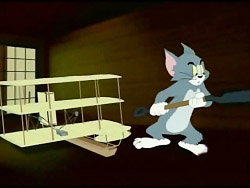 The Wrights build bigger gliders, large enough for a man, bit still piloted by the mouse – and with Tom still taking it in the face by being smacked into smokestacks from below. Now, the experiments move into powered flight, with the brothers testing small models for lift in an artificial wind tunnel. During a break after an unsuccessful test, the brothers leave the tunnel unattended, while Tom, carrying a shovel as a weapon, chases Jerry inside. Jerry exits through a small opening at the other end, leaving Tom inside the cylinder, while Jerry reaches the switch that powers the tunnel’s wind machine. Jerry activates the switch, and turns the fan blades off and on intermittently, causing the shovel to be forcefully blown to smash repeatedly into Tom’s face. At one point, the machine is put into high speed. To the rear of Tom is the brothers’ flight model, constructed as a triplane, and as Tom is blown out of the tunnel, he snaps off the top wing, reducing the model to its familiar biplane form. The brothers return to find that the model now works with one wing removed, and another breakthrough is made.
The Wrights build bigger gliders, large enough for a man, bit still piloted by the mouse – and with Tom still taking it in the face by being smacked into smokestacks from below. Now, the experiments move into powered flight, with the brothers testing small models for lift in an artificial wind tunnel. During a break after an unsuccessful test, the brothers leave the tunnel unattended, while Tom, carrying a shovel as a weapon, chases Jerry inside. Jerry exits through a small opening at the other end, leaving Tom inside the cylinder, while Jerry reaches the switch that powers the tunnel’s wind machine. Jerry activates the switch, and turns the fan blades off and on intermittently, causing the shovel to be forcefully blown to smash repeatedly into Tom’s face. At one point, the machine is put into high speed. To the rear of Tom is the brothers’ flight model, constructed as a triplane, and as Tom is blown out of the tunnel, he snaps off the top wing, reducing the model to its familiar biplane form. The brothers return to find that the model now works with one wing removed, and another breakthrough is made.
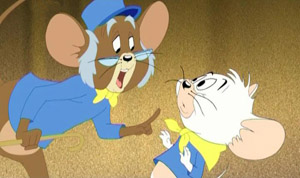 The full-sized Wright Flyer is designed, and transported along with the mouse and cat, by train to assemble at the Kitty Hawk testing site. In transit, the brothers discover that one of their propellers is broken, and ponder how to fix it, knowing that two props are needed to make it go. Meanwhile, Tom is again in pursuit of Jerry, and their paths lead across the wings of the Wright Flyer. Jerry pauses at the center of the device, at the engine throttle as Tom approaches, then engages the engine just as Tom’s tail comes dangerously close to the engine’s criss-crossing power belts. Tom is dragged into the engine mechanism, travels along the belt to the hub where the missing propeller remains to be installed, and grabs onto the rotating axle designed to spin the propeller. Tom ends up in a helpless blue spin, providing the same whirling effect as the missing prop. The plane begins to move down its train-like launching track, as Jerry grabs onto the control stick. The plane rises, to the amazement of the brothers, who watch in awe as the plane gains altitude, turns (a feat which actually would not be accomplished until a later design modification), and then is “coming right at us!” The brothers turn and flee as Jerry flies back over the launching track. The nose of the plane collides with Orville, flipping him into the air, and onto the pilot’s controls in place of Jerry. The plane rises again when just past the track, and Orville calls out, “Don’t just stand there, Wilbur. Take my picture.” The scene is transformed into the famous photo of the Wright Flyer’s takeoff back in the museum, as the guide mouse concludes his story, noting that the humans will get all the credit, but it was the mouse that made the flight. However, the child to whom he has been telling the story is not convinced. “Don’t you have any proof? Some corroboration?” The guide looks backwards over his shoulder, and calmly asks, “Isn’t that the way it happened, Tom?” Above them, another guide, an aged gray cat in white sideburns, goatee, and glasses, leading a group of school-aged kittens, responds “Yep. That’s pretty much it, Jer.” To wrap up this surprise revelation, Tom’s charges eye Jerry’s students hungrily, and a five-way chase ensues between cats and mice around the museum, with Tom announcing that “Everyone will meet back here in 15 minutes”, for the iris out.
The full-sized Wright Flyer is designed, and transported along with the mouse and cat, by train to assemble at the Kitty Hawk testing site. In transit, the brothers discover that one of their propellers is broken, and ponder how to fix it, knowing that two props are needed to make it go. Meanwhile, Tom is again in pursuit of Jerry, and their paths lead across the wings of the Wright Flyer. Jerry pauses at the center of the device, at the engine throttle as Tom approaches, then engages the engine just as Tom’s tail comes dangerously close to the engine’s criss-crossing power belts. Tom is dragged into the engine mechanism, travels along the belt to the hub where the missing propeller remains to be installed, and grabs onto the rotating axle designed to spin the propeller. Tom ends up in a helpless blue spin, providing the same whirling effect as the missing prop. The plane begins to move down its train-like launching track, as Jerry grabs onto the control stick. The plane rises, to the amazement of the brothers, who watch in awe as the plane gains altitude, turns (a feat which actually would not be accomplished until a later design modification), and then is “coming right at us!” The brothers turn and flee as Jerry flies back over the launching track. The nose of the plane collides with Orville, flipping him into the air, and onto the pilot’s controls in place of Jerry. The plane rises again when just past the track, and Orville calls out, “Don’t just stand there, Wilbur. Take my picture.” The scene is transformed into the famous photo of the Wright Flyer’s takeoff back in the museum, as the guide mouse concludes his story, noting that the humans will get all the credit, but it was the mouse that made the flight. However, the child to whom he has been telling the story is not convinced. “Don’t you have any proof? Some corroboration?” The guide looks backwards over his shoulder, and calmly asks, “Isn’t that the way it happened, Tom?” Above them, another guide, an aged gray cat in white sideburns, goatee, and glasses, leading a group of school-aged kittens, responds “Yep. That’s pretty much it, Jer.” To wrap up this surprise revelation, Tom’s charges eye Jerry’s students hungrily, and a five-way chase ensues between cats and mice around the museum, with Tom announcing that “Everyone will meet back here in 15 minutes”, for the iris out.
Here’s a clip:
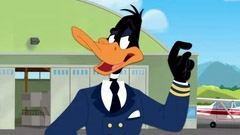 Finally, The Looney Tunes Show provides two late flying adventures worth noting. In Spread Those Wings and Fly (2/12/13), Daffy takes the motto of a self-help tape program too seriously, and believes he is destined to become a commercial pilot. He enrolls in courses, buys a flashy pilot’s uniform, but is a total washout in the flight simulator, crashing over and over again, yet begging, “Now let’s try it for real.” Flunked out of the school, he still follows the motivational course’s directive to seize the opportunity, and, license or no license, “borrows” an unattended plane for his first solo. He leads ground crewmen on a merry chase, as his plane never gets off the ground, but instead enters a hangar, clipping off both wings and cracking up against the opposite wall. Daffy’s pilot career is through, but, still determined to “spread his wings”, he gets to fly anyway – dressing in drag to apply for the position of a stewardess. “You know, they have male stewards”, his employer reminds him. “I like the height the heels give me”, responds Daffy, content to remain in masquerade, and effeminately swish his hips as he heads for his first assignment.
Finally, The Looney Tunes Show provides two late flying adventures worth noting. In Spread Those Wings and Fly (2/12/13), Daffy takes the motto of a self-help tape program too seriously, and believes he is destined to become a commercial pilot. He enrolls in courses, buys a flashy pilot’s uniform, but is a total washout in the flight simulator, crashing over and over again, yet begging, “Now let’s try it for real.” Flunked out of the school, he still follows the motivational course’s directive to seize the opportunity, and, license or no license, “borrows” an unattended plane for his first solo. He leads ground crewmen on a merry chase, as his plane never gets off the ground, but instead enters a hangar, clipping off both wings and cracking up against the opposite wall. Daffy’s pilot career is through, but, still determined to “spread his wings”, he gets to fly anyway – dressing in drag to apply for the position of a stewardess. “You know, they have male stewards”, his employer reminds him. “I like the height the heels give me”, responds Daffy, content to remain in masquerade, and effeminately swish his hips as he heads for his first assignment.
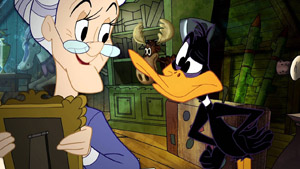 And in Eligible Bachelors (7/5/11), Daffy spends a day of doing odd jobs for Granny, but is sidetracked from his tasks by Granny’s recounting of days of long ago – dispelling entirely the myth that she was always a befuddled fuddy-duddy. In flashback to the days of WWII, we find that in her day, she was a resourceful, energetic brunette enlisted in the WACs, doing investigation of art thefts by the Nazis inside occupied France. She encounters a substitute for a carrier pigeon being used by the Resistance – a grandfather of Tweety, who doesn’t prove very useful at message delivery, but is brave enough to save Granny from a fall when she is vibrated off of the Eiffel Tower by a Nazi dirigible, by catching Granny’s hooded coat in his small talons, and flying her to safety. The dirigible is piloted by an officer in charge of the art thefts, who decides to take along France’s most artistic prize of all – the entire tower, which the dirigible uproots from its foundation and carries away. Great-Grandfather Tweety and Granny-to-be follow through Tweety’s flight, dodging machine gun fire from the dirigible’s gondola, and Granny is deposited upon the top of the dirigible’s gas bag. The German Officer emerges from a roof hatch in the bag structure, and confronts Granny, who demands he return the stolen art. “I take no orders from a woman”, says the officer. “I’m not just a woman – – I’m a WAC!!”, shouts Granny, delivering a judo-style kick into the officer’s midriff. A fierce bout of hand-to-hand combat ensues, in which Tweety joins in, somehow getting the villain to tangle his feet in strands of rope hanging from bindings around the dirigible’s bag frame. As the villain finds his ankles fouled, Tweety flies directly in his face. “What are you?” asks the officer. “Your worst nightmare”, underplays Tweety. He gives the officer a nudge in the face, causing him to fall over the side, dangling from the rope by his heels. Granny and Tweety become heroes, and the scene returns to the present, where Granny states that after the other art works were returned to the museum, Granny received a special reward. She looks upwards above her cottage home – and there, looming above them, is the Eiffel Tower! Daffy comments, “You’d think I’d’ve noticed that by this time.” However, he curiously asks, “Then what’s that thing they’ve got in France?” Granny whispers her reply in Daffy’s ear: “It’s a FAKE.”
And in Eligible Bachelors (7/5/11), Daffy spends a day of doing odd jobs for Granny, but is sidetracked from his tasks by Granny’s recounting of days of long ago – dispelling entirely the myth that she was always a befuddled fuddy-duddy. In flashback to the days of WWII, we find that in her day, she was a resourceful, energetic brunette enlisted in the WACs, doing investigation of art thefts by the Nazis inside occupied France. She encounters a substitute for a carrier pigeon being used by the Resistance – a grandfather of Tweety, who doesn’t prove very useful at message delivery, but is brave enough to save Granny from a fall when she is vibrated off of the Eiffel Tower by a Nazi dirigible, by catching Granny’s hooded coat in his small talons, and flying her to safety. The dirigible is piloted by an officer in charge of the art thefts, who decides to take along France’s most artistic prize of all – the entire tower, which the dirigible uproots from its foundation and carries away. Great-Grandfather Tweety and Granny-to-be follow through Tweety’s flight, dodging machine gun fire from the dirigible’s gondola, and Granny is deposited upon the top of the dirigible’s gas bag. The German Officer emerges from a roof hatch in the bag structure, and confronts Granny, who demands he return the stolen art. “I take no orders from a woman”, says the officer. “I’m not just a woman – – I’m a WAC!!”, shouts Granny, delivering a judo-style kick into the officer’s midriff. A fierce bout of hand-to-hand combat ensues, in which Tweety joins in, somehow getting the villain to tangle his feet in strands of rope hanging from bindings around the dirigible’s bag frame. As the villain finds his ankles fouled, Tweety flies directly in his face. “What are you?” asks the officer. “Your worst nightmare”, underplays Tweety. He gives the officer a nudge in the face, causing him to fall over the side, dangling from the rope by his heels. Granny and Tweety become heroes, and the scene returns to the present, where Granny states that after the other art works were returned to the museum, Granny received a special reward. She looks upwards above her cottage home – and there, looming above them, is the Eiffel Tower! Daffy comments, “You’d think I’d’ve noticed that by this time.” However, he curiously asks, “Then what’s that thing they’ve got in France?” Granny whispers her reply in Daffy’s ear: “It’s a FAKE.”
This clip isn’t the dirigible scene… but what the hey…
A mixed bag of uplifting studios, next week.


 Charles Gardner is an animation enthusiast who toils by day as a member of LA Law – but by nights and weekends indulges in classic jazz and ragtime as a performer; and studies classic Hollywood cartoons… maybe a little too much.
Charles Gardner is an animation enthusiast who toils by day as a member of LA Law – but by nights and weekends indulges in classic jazz and ragtime as a performer; and studies classic Hollywood cartoons… maybe a little too much.


































































































































































“Why didn’t they use Clyde?” Well, since Bugs addressed his nephew as “Clyde” at the end of the cartoon, apparently they did. Maybe puberty is doing weird things to Clyde’s voice and complexion. Or maybe Bugs has two nephews named Clyde. Or maybe Bugs picked up the habit of calling everybody “Clyde” from Eddie Haskell in reruns of “Leave It to Beaver”. At least it wasn’t Shorty from “Rabbit’s Kin”; I could never understand a single thing he says in that super-sped-up voice.
Those late 20th-century Bugs and Daffy cartoons were a lot better than I expected. I had a good laugh at the bit where Bugs uses the Tasmanian Devil’s whirling motion to sharpen his pencil.
Animaniacs had a surprising number of South Sea Island cannibals for a TV show of the 1990s, by which time cartoons like “Pop Pie a la Mode” had long since vanished from the airwaves. They managed to avoid old-fashioned racial stereotypes by either putting the natives behind masks, as in “Plane Pals”, or presenting them as white, for example “Bert, who is a cannibal” in the Gilbert and Sullivan spoof “HMS Yakko”. Also, in the Pinky and the Brain episode “Brainania”, the Brain becomes the ruler of a South Pacific island inhabited by Aussie-accented white cannibals. Given that the world’s most famous cannibal at the time was Jeffrey Dahmer, a white guy from Wisconsin, I suppose it was fair enough.
I think “Eligible Bachelors” was by far the best episode of “The Looney Tunes Show”, proving that June Foray could still deliver a tour-de-force performance at 92!
Honestly, I thought “The Fright Before Christmas” was the best of the DFE Special cartoons. I espiecally like the part where Taz-Boy eats the Chrismas trees as Bugs reads his nephew’s large wish list.
Warner Bros.Animation (and maybe Marvel Productions, whcih DFE BECAME) produced DAFFY DUCK’S MOVIE..
The gremlin theme was revisited in “The Scare Up There” (11/2/96), an episode of “The Sylvester & Tweety Mysteries”. Granny and her entourage of pets take a 17-hour flight in order to find out who’s been stealing all the little packets of complimentary peanuts (spoiler: it was the Tasmanian Devil, disguised as a stewardess). Meanwhile, a trio of gremlins tries to wreck the plane, and Sylvester is the only one who sees them. These gremlins are human above the waist and airplanes below, and they utter a lot of the same radio catchphrases favoured by Bob Clampett (“Could be!” “Well, now I wouldn’t say that!”). In an amusing touch, the baggage carousel at the airport, like so many conveyor belts in Warner Bros. cartoons, is musically accompanied by Raymond Scott’s “Powerhouse”.
“Histeria!” devoted an episode to the “History of Flight” (6/2/99), a subject it unsurprisingly handled less well than Disney. In it, the Wright brothers land their plane at a present-day airport and are forced to suffer all the nightmares of modern air travel. In another segment, Ferdinand Magellan interviews Amelia Earhart. There’s more, but I’d prefer not to dwell on this awful show and its overpopulated cast of annoying characters.
“Kitty Hawked” is almost a remake of a much cheaper Tom and Jerry cartoon by, of all people, Filmation Studios in 1980, “Kitty Hawk Kitty”. https://youtu.be/0bFaQnRzXgY
I had forgotten how horrible this Filmation T&J show was. Now I remember.
To Paul Groh: Hey! I happen to like Histeria’s Ms. Information, Charity Bazaar, & Pepper Mills. It was no Animaniacs, true, but former Animaniacs & future 7D’s writer Tom Ruegger did a remarkable job of it. It was censors that had little patience for it, particularly the infamous but funny satire of French politics. Oh well, to each their own, one cartoon fan’s garbage is another cartoon fan’s treasure, right? Now what they did to Lola Bunny on The New Loony Tunes Show, that was unforgiveable. They turned a street-smart, sexy basketball player into a complete ditz(not unlike My little Pony’s Derpy Hooves) in an attempt to make her “more loony”. When it comes to ditzy dames characters, Leni Loud has more staying power. And I’m not saying that because I’m a Metro Detroit resident like The Loud Family.
To Debbie Perry: Those old Filmation cartoons are pretty mediocre. Filmation had some memorable characters, but they were not a studio known for high quality or top budgets spent on animated scenes. They also have the now old shame of having a now-disgraced Bill Cosby cartoon on their roster. What was once watchable is now considered shameful in separating the man from the myth. Though he is as loathsome as Cosby in his guilt for sexual grooming, John Kricsfalusi once stated that he worked on Filmation cartoons (particularly during the “Tom & Jerry” & “He Man” era) and loathed working for that studio, stating that it was the worst one in the world for expressing funny animation, but then again, John is such a curmudgeon when it comes to complaining about so-called ‘bad” animation. This is why no one today will touch him with a ten-foot pull to do any projects. He’s really that toxic .As for his horrible criticisms about “Animaniacs”, no comment; the grouch didn’t even see the episodes when he reviewed the show; he was looking for an excuse to vent his spleen on Steven Spielberg, whom he hates for some reason. Their Star Trek cartoon, on the other hand is a real hoot. They capture Bill Shatner’s serious but dopey male gaze to perfection. By the way, I love your cartoon strips with the cat & mouse. You’re really a talented artist and should do more cartoons more often. Keep up the good work.
Thank you. I try, but it’s getting harder to push myself to keep drawing these things.
I like the Looney Tunes specials! While I understand that “Daffy Flies North” is a retread of ” Pinto Pink”, it’s new, high quality animation! (which I think is an important distinction to make)
6/25/22
RobGems68 Wrote:
Yeah, “Pinto Pink” & “Daffy Flies North” do have their occasional moments, but that laughing horse can really get on your nerves; Really, he’s such a pain in the butt to Daffy & Pink Panther so much with his rudeness that you’d wish you’d send him to the glue factory. Oh well, Friz Freleng loved comic situations like this. And he loved to be repetitious in his repeating gags over & over with different characters. It simply meant he and his storywriters were sometimes running out of fresh ideas. Even the “hello nurse” gag quote repeated over & over on “Animaniacs” start to get tedious after a handful of times.
Animaniacs?! Tiny Toons?! Batman TAS?! The Looney Tunes Show?! All my favorites are here, Charlie!